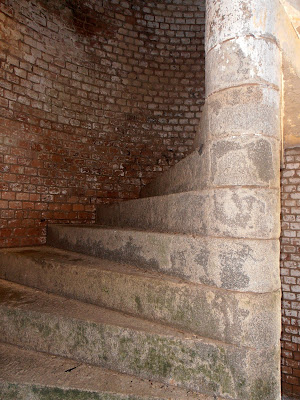Our mid-February, 2013, day trip to the Dry Tortugas National Park began with an 8 AM departure from Key West aboard the Yankee Freedom III. We parked in the city parking garage for $13 as recommended by the boat company. Ferry tickets should be purchased in advance to assure space is available and are $165 per adult including the $5 park entrance fee. The ferry is certified for 250 people, but only books 150 passengers per their contract with the park service. The ferry is a modern catamaran that can cover the 70 mile distance to the Dry Tortugas in approximately 2 hours and 15 minutes. A breakfast buffet is available on the ride to the park and a sandwich buffet is provided while docked at Garden Key. Juice and coffee are available with breakfast while soda and bottled water are available with lunch.
At a cruising speed of just over 30 miles per hour, even fairly smooth seas can cause motion sickness in some people. The ferry sells single dose motion sickness pills, but it usually takes about 30 minutes for the medicine to start working. The ferry also has the only working toilets in the vicinity of the park. Waiting until the last minute is not advised as there is often a line. It is also worth noting the the motion-activated hand dryer is on the bulkhead opposite the sink. If the boat rocks much at all, you are apt to feel an unexpected warm breeze on your backside while washing your hands.
The Dry Tortugas are at the western end of the Great Florida Reef which arcs from Biscayne Bay along the Florida Keys to the Dry Tortugas. On June 21, 1513, an expedition led by Juan Ponce de León discovered the islands and the anchorage. They did not find any fresh water, but did find giant sea turtles. The United States acquired Florida in 1821 and began construction of Fort Jefferson in 1846. Due to its extremely remote location, the fort was designed to withstand a year-long siege by General Joseph Totten, the Chief Engineer of the US Army Corps of Engineers. The fort is mostly constructed of unreinforced poured concrete with a brick façade. While construction continued until 1889, the fort was never completed as steam propulsion and large naval rifled artillery rendered the fort a relic of technology. During the Civil War, the fort was used as a naval base for the US Navy's blockading force. In addition, it was used as a prison for captured Confederate soldiers. From 1865 until 1869, Dr. Samuel Mudd was imprisoned at the fort.
 |
| Approaching Fort Jefferson on Garden Key |
The park relies on the ferry operator to provide guided tours of the fort. The ferry also provides snorkeling equipment and fresh water rinses. As we only had about 4½ hours in the park, we chose not snorkel or sign up for the guided tour, but to explore on our own using the self-guided tour booklet available on the ferry and produced by the park service.
The volunteer running the bookstore was the only worker in the visitor center. The visitor center is rather small, but had several coral specimens on a touch table. There was evidence that a video could be displayed on a monitor, but the volunteer was either too busy or too preoccupied with getting back to Key West after several days on Garden Key to get the video going.
 |
| A few hardy trees survive on the parade ground |
 |
| Inside Fort Jefferson |
 |
| Bastions provide interlocking fields of fire |
 |
| Looking out a casemate across the moat to Bush Key |
 |
| Clockwise spiral stairs lead to the second tier casemates |
 |
| The drifting sands have temporarily connected Bush Key to both Garden Key and Long Key |
 |
| A second tier corridor with some of the over 16,000,000 bricks in the fort |
 |
| Ruins of enlisted quarters |
 |
| Yankee Freedom III docked at Garden Key |
 |
| Two tiers of casements and a rooftop third tier overlook the 70 foot wide moat |
 |
| Ruins of the north coaling dock |
 |
| Sea grass and sand provide contrasting shades of turquoise |
 |
| Ruins of the soldier's quarters and the intact powder magazine |
 |
| Ruins of the officer's quarters on the parade ground and three traverse magazines on the third tier |
 |
| No longer an official navigational aid, Garden Key light is now just a harbor light |
 |
| Loggerhead Key lighthouse is 3 miles west of the fort |
 |
| Incredible colors |
 |
| Walkway laid out with military precision |
 |
| The weathering iron totten shutters on the casements have damaged the scarp wall |
 |
| A vessel navigates the channel between Garden Key and Loggerhead Key |
 |
| The new mortar makes the scarp wall repairs obvious |
 |
| Coral as seen from the moat wall |
 |
| A sand bar has invaded the moat |
 |
| Changing facility for snorkelers |
 |
| The sand bar connecting Bush Key to Garden Key blocks the former channel |
 |
| Frigate birds sailing on the winds |
Even with a literal boatload of tourists on the sixteen acre key, it often seemed like we had the place to ourselves. Although visiting the Dry Tortugas took a great deal of planning and was a rather expensive adventure, our day trip was priceless in the enjoyment and memories it provided.
The website for the ferry is http://www.yankeefreedom.com.
The park website is http://www.nps.gov/drto/index.htm.

No comments:
Post a Comment